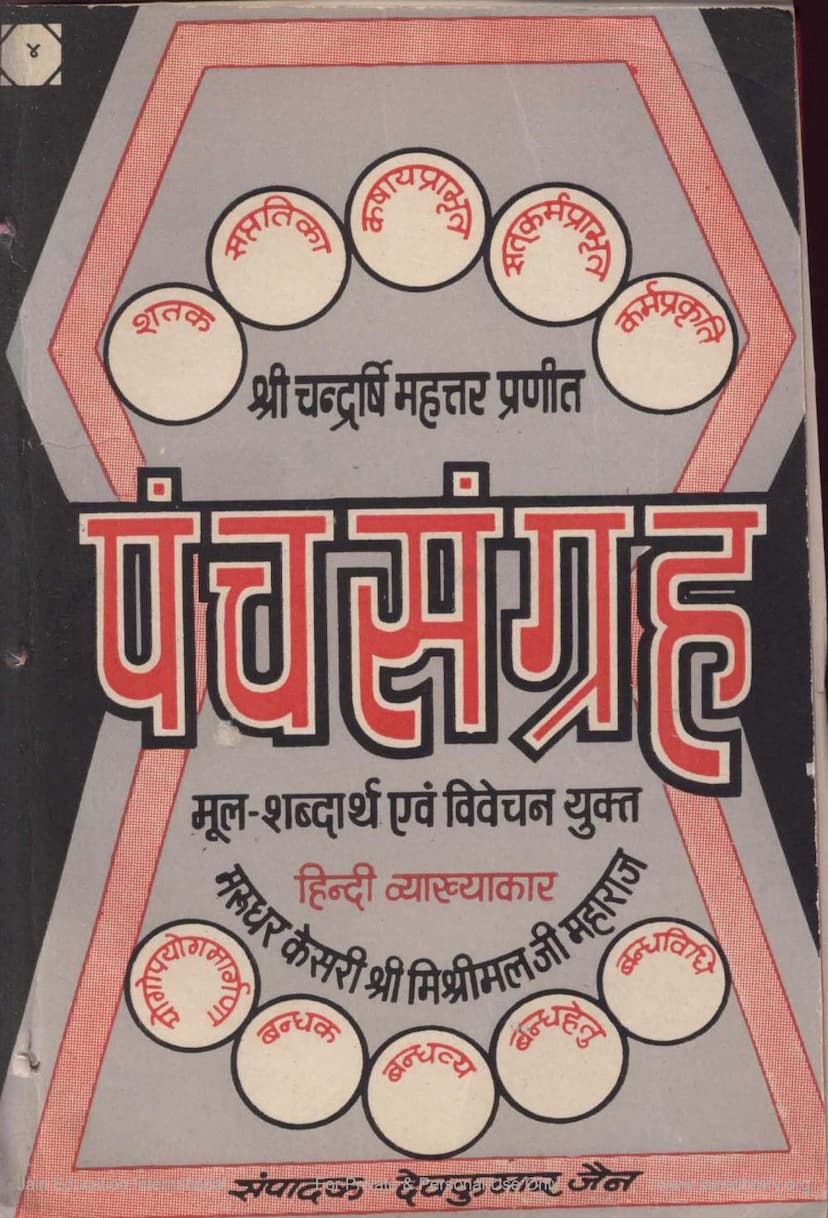Panchsangraha Part 04
Added to library: September 2, 2025

Summary
This Jain text, "Panchsangraha Part 04" (also referred to as "Panchsangraha (4)"), authored by Chandrashi Mahattar and interpreted by Shree Mishrimallji Maharaj (also known as Marudhar Kesari, Shramansurya), with editing by Devkumar Jain Shastri and sponsored by Shree Sukhan Muni, is published by Acharya Shri Raghunath Jain Shodh Sansthan, Jodhpur. It is the fourth part of a larger work, focusing on the "Bandhhetu-Prarupana Adhyaya" (Chapter on the Causes of Bondage).
The book is a comprehensive exposition of the Jain theory of karma, specifically detailing the causes that lead to the soul's bondage (karma bandha). The core philosophy presented is that the soul, inherently pure and powerful, becomes entangled in the cycle of birth and death due to karma. This entanglement, the text explains, is not due to an external force but rather a consequence of the soul's own internal states and actions.
Key concepts discussed in the book include:
- The Nature of Karma: Karma is identified as subtle matter (pudgala) that binds to the soul. This binding is initiated by the soul's passions (kashayas) like anger, pride, deceit, and greed, and facilitated by activities of mind, speech, and body (yoga).
- The General Causes of Bondage (Bandhhetu): The text elaborates on the primary causes of karma bondage. While various classifications exist in Jain literature, this part of "Panchsangraha" primarily focuses on four core causes:
- Mithyatva (Mithyadarshan): Delusion or incorrect perception of reality, including wrong beliefs and attachments to false principles.
- Avirati: Non-restraint or lack of abstinence from actions that lead to harm. This encompasses non-restraint regarding the senses, mind, and various types of living beings (ekendriya to panchendriya).
- Kashaya: Passions like anger, pride, deceit, and greed, which are considered the primary driving force behind karma accumulation.
- Yoga: The activities of mind, speech, and body, which act as the channel through which karma enters the soul.
- Sub-categories of Causes: The text details the numerous sub-categories of these primary causes, quantifying them for each. For instance, Mithyatva is divided into five types (Abhigrahik, Anabhigrahik, Abhiniveshik, Sanshayik, Anabhog), Avirati into twelve, Kashaya into twenty-five (including the sixteen kashayas and nine nokashayas), and Yoga into fifteen.
- Bondage across Stages of Spiritual Evolution (Gunsthana): A significant portion of the book is dedicated to analyzing how these causes of bondage manifest across the fourteen stages of spiritual development (Gunsthanas) in Jainism. It explains which causes are operative at each stage and how their intensity or nature changes, leading to the gradual shedding of karma and the eventual liberation of the soul.
- Bondage in Different Life Forms (Jivsthana): The text also examines how these causes of bondage apply to different categories of living beings, from the one-sensed beings (ekendriya) to the fully developed five-sensed beings (panchendriya), including those with and without knowledge (sanjnni and asanjnni) and those in various stages of development (paryapta and aparyapta).
- Detailed Analysis of Frequencies (Bhangan-Sankhya): A substantial part of the book involves a complex mathematical calculation of the various combinations and permutations of these causes, leading to a vast number of "bhangan" (frequencies or specific instances of bondage). This detailed analysis highlights the intricate workings of karma according to Jain philosophy.
- Special Cases: The text discusses specific karmic influxes like Tirthankar nama karma and the two types of "Aharaka" karma, detailing their unique causes (Samyaktva and Samyama, respectively) and the specific stages where they can be acquired.
- The Role of Passions and Activities: The book emphasizes that while yoga brings karmic particles to the soul, it is the kashayas that bind them. It further categorizes bondage into four aspects: Prakriti (nature of karma), Sthiti (duration), Anubhaga (intensity), and Pradesha (quantity). Yoga is primarily responsible for Prakriti and Pradesha bandha, while Kashaya is responsible for Sthiti and Anubhaga bandha.
- The Significance of the Text: The "Panchsangraha" is considered a fundamental text for understanding the intricacies of Jain karma theory. This commentary by Shree Mishrimallji Maharaj makes the complex original text accessible to a wider audience, especially those seeking knowledge in Hindi. The publication also serves as a tribute to his profound scholarship and dedication to propagating Jain teachings.
In essence, "Panchsangraha Part 04" is a deep dive into the causal mechanisms of karma bondage in Jainism, offering a systematic and analytical framework for understanding how the soul accumulates karma and the path towards its eventual liberation.